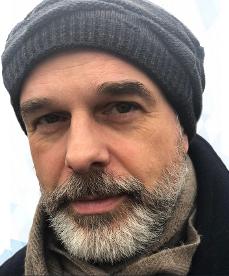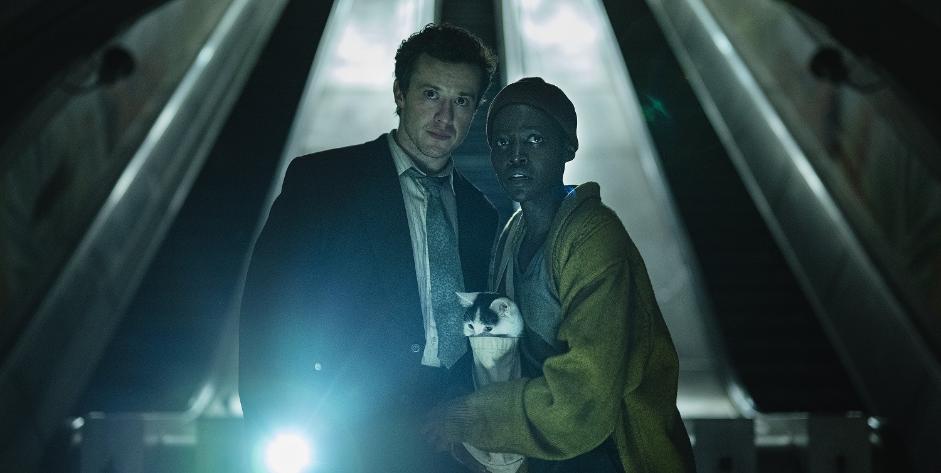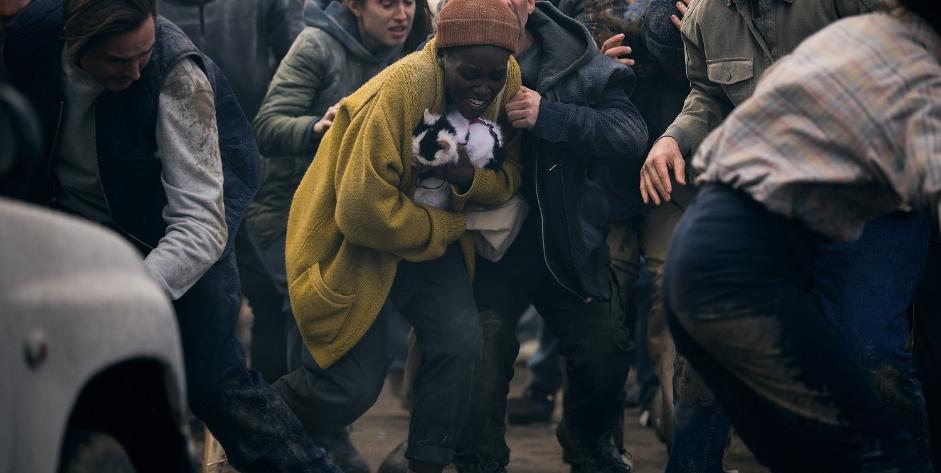
A QUIET PLACE: DAY ONE
Simon Bowles (Production Designer) Q&A
Since starting out on Edgar Wright’s lo-fi 1995 feature debut, A Fistful Of Fingers (a film, it’s tagline boldly claimed was, ‘The Greatest Western Ever Made… In Somerset’), Simon Bowles has established himself as an award-winning, multi-faceted production designer. One with a penchant for detail. And blood.
“I have had a lot of discussions in my career about gore, about where the blood would splatter if someone’s head has just been taken off,” he deadpans, “which is interesting, being a vegetarian!”
For A Quiet Place: Day One, Bowles is returning to a city he knows inside out, having made three movies there previously. One of which, Natalie Erika James’ upcoming Apartment 7A, will see him deliver another anticipated prequel to another iconic horror property – in that case, Rosemary’s Baby.
But with A Quiet Place: Day One, Bowles’ task was bigger than ever before. Needing to not just capture the noisy glory of NYC but to then raise it to rubble too, for the aftermath of its apocalyptic creature attack, he realised that the only way to do its story true justice was to, well, shoot it in London.
“We wanted to shoot on a backlot [in this case, at Leavesden] so we could destroy everything properly!” Bowles laughs. “On location, we’d have been able to do small things, but I wanted to do something much bigger. I wanted to see the crater holes where meteorites had crashed diagonally through buildings. To see that massive scar through the structure and the consequences of the impact; that the meteorite has clipped a car, and that car has ended up inside a building, on its side, and then caught fire.”
Having recced the city with the film’s director, Michael Sarnoski, paying equal attention to what it both looked and sounded like, Bowles’ team built multiple versions of four New York City blocks, each two storeys high. “We see this city torn apart, spectacularly,” Bowles chuckles. “I wanted audiences to be like, ‘Oh my God!’ We show the city in all its glory, full of people and life, and then destroy it!”
For the cast, Bowles’ attention to authenticity was an invaluable support when it came to their performances. And, for audiences, all that detail will immerse them in the horrors of what experiencing an attack by these creatures would really be like, at ground level – and lower.
“In the subway sequence [in which Lupita Nyong’o’s Samira, her cat, Frodo, and Eric, played by Joseph Quinn, are chased into a flooded tunnel], the audience needs to feel the harshness of this environment,” Bowles says. “To empathise with the predicament they’re in.”
Thanks to Bowles, the sequence proved something of a predicament for the actors too, the production designer looking back to his acclaimed work on horror classic The Descent in 2005 – for which he constructed a vast network of underground tunnels – to deliver something even more effective.
“One of the things I discovered on The Descent was that rather than trying to raise water levels, it's much easier to lower the scenery. It gives you that real sense of claustrophobia,” Bowles says, then smiles. “Another thing I learned was that the solution [in this kind of sequence] is to make it quite difficult for the actors, but very easy for the crew. If the actors are really having to duck down and endure it all, the set-piece becomes so much more realistic, and the audience can truly empathise with them!”
This is the first time we’ve seen an A Quiet Place story unfold
in a major city. What was your start point when it came to recreating
New York?
“I’ve actually done three movies set in New York,
prior to this: [Roger Michell’s] Hyde Park On Hudson, [Florian Zeller’s]
The Son, and [Natalie Erika James’ upcoming Rosemary’s Baby prequel]
Apartment 7A. I feel very comfortable there. I started delving into my
journey for A Quiet Place: Day One in Chinatown, travelling literally by
foot, with Michael [Sarnoski], through all the different
neighbourhoods, falling in love with all of them. Visually, I was cherry
picking the differences, the things that made those neighbourhoods
individual, from the types of stores to their colour schemes. These
things change quite dramatically in each area, even small things like
the graffiti. Even the trash cans are different. It was about giving
each of these locations within the city their own identity.”

And you then recreated all of that at Leavesden, in London…
“Yes! We took that essence and brought it all the way to London and
built a massive set, two storeys high and four blocks in size. We were
able to dress those blocks as Chinatown [and shoot those scenes],
destroy it, and then redress them as the next neighbourhood.”
That’s a huge undertaking, which might explain why your director,
Michael Sarnoski, says you have a "serial killer’s wall” in your
office?
“[Laughs] That's how I work, yes. On this, I took all
my reference images and had a separate wall for each of the
neighbourhoods we were going to be traveling through in the movie. I
have fabric samples and paint samples on these boards, so it’s not just
Michael and I who can discuss the look and feel, but also the
cinematographer, hair and make-up, cast, everyone. All departments are
able to go up and touch the walls, feel the textures, see examples of
the props and models of the sets. I love having a hub for everybody
that's involved creatively, somewhere they can experience the movie,
even before the sets are built. Then, as we're designing the sets, I put
all of it into virtual reality, build it all in 3D, so Michael can
essentially walk around the space and explore, figuring out the angles,
lining up his shots with his DoP.”
Lupita Nyong’o says all this detail is brilliant for supporting
performances. She also says that, as someone who lived in New York for
11 years, what you’ve created is incredibly accurate.
“That’s
lovely to know, and it really is accurate! I've taken the key places and
stores in the city and put them together so even New Yorkers have a big
connection to what they're seeing. That's important because we're about
to see this city destroyed, spectacularly. I wanted audiences to be
like, ‘Oh my God!’ It’s upsetting for New Yorkers to see it, because we
show the city in all its glory, full of people and life, and then
destroy it!”
Tell us about the noise levels in the city. How did you lean into the aural soundscape that these creatures descend into?
“As an example, there’s a games arcade in Chinatown, on Mott Street. I
made sure we featured that because that, obviously, makes a lot of
noise. I brought out anything that's noisy in the city, like the buskers
in Chinatown, with their fantastic string instruments. All that life,
energy, passion. After the creatures attack, all those sounds go silent.
When we were scouting, I made a note of anything that was causing
noise, like these guys in Chinatown with big drums, or a guy who was
wheeling a trolley down the street. I’ve got such a visual and aural
memory of the wheels on the bottom of his trolley squeaking and turning
and bumping over things. All these little details. All those real
memories, we put them all into the movie.”
Tell us about shooting in sequence. How did that process work?
“We built Chinatown intact, then did a massive destructive revamp on
it. That’s why we wanted to shoot on a backlot – so we could destroy
everything properly! If we’d shot on location, we’d have been able to do
small things, but I wanted to do something much bigger. I wanted to see
the crater holes in the ground where these meteorites [that the
creatures are inside] had hit, spreading soil everywhere, where
meteorites had crashed diagonally through some buildings. To see that
massive scar through the buildings and the consequences of the impact;
that the meteorite has clipped a car, and that car has ended up inside a
building, on its side, and then caught fire. And that the creatures
have torn through all of it, peeled its roof off like a lid, to get to
the food inside. And we wanted to get as much of that as possible in
camera. That way, ILM, who did all the amazing visual effects, would
have something real and tangible to look at.”
What do these creatures do to New York and how did you manifest that when it came to the production design?
“They tear it to pieces. We had so many discussions on what that level
of destruction looks like, but also what that destruction looks like on a
more focussed level too. We had all these thoughts about what a
creature’s claw can do, the destructive impact it can have. What it
looks like when one of those claws punctures a brick. What happens when
the creatures pull those claws back out of a window frame or a
doorframe, having prised them open to get to the people inside. When
they pull their claws back out, those bricks will pull out and rotate.
All these aspects were thought through in forensic detail.”
Did you look to the previous two A Quiet Place movies when it came to exploring these creatures’ destructive capabilities?
“To an extent. But those movies were more about chasing. With this, we
wanted to investigate the way the creatures react to this new
environment. So, we 3D-printed a whole creature arm and hand, which was
hilarious as ILM had only ever seen these creatures on a computer screen
before, never physically. By 3D-printing the arm and claw, they were
able to look at it and really understand it, to ask questions. Like,
‘Are these creatures all hard, like a crab, or are there fleshy bits on
them?’ That helped us pinpoint what they could do. In the first two
movies, the buildings are made, mostly, of timber. Here, we wanted to
see the creatures interacting with a harder environment. For these
creatures, New York is like a human buffet, with all the snacks hidden
inside these hard structures. Our questions were around what were the
easiest, most practical ways in which these creatures could get inside;
what they could peel away to get to their prey, and what the aftermath
of that process would look like. It was questions of where all the blood
splats would be if someone had had their head taken off, where the claw
marks on the surroundings would be from the moments where the creatures
have overreached in their attacks.”
You’ve worked on some seminal horror movies before, like The Descent. How did those experiences help you on this?
“Yes, I have had a lot of discussions in my career about gore, which is
interesting, being a vegetarian! But something like The Descent, for
which we had to build a whole underground tunnel environment, did come
in handy on this one. Especially for the subway sequence.”
Tell us about how you constructed that subway sequence.
“Actually, the subway sequence [in which Lupita Nyong’o’s Samira and
Joseph Quinn’s Eric – plus Samira’s cat, Frodo, are chased into a
flooded subway by the creatures] wasn't in the original script. Michael
said, ‘I'm thinking about a flooded subway scene.’ I thought it was a
great idea. And one of the things I discovered on The Descent was that
rather than trying to raise water levels, it's much easier to lower the
scenery. It gives you that real sense of claustrophobia, that small
amount of air that your characters have got left. Another thing I
learned on The Descent was that the solution [in this kind of sequence]
is to make it quite difficult for the actors, but very easy for the
crew. [Laughs] If the actors are really having to duck down and endure
all of this, the set-piece becomes so much more realistic, and the
audience can truly empathise with the predicament they’re in. The
audience needs to feel the harshness of this environment. That these
characters are exposed. That tunnel is rife with danger.”

Lupita said the water in the subway sequence was very grimy. What happens in the sequence and how did you create that effect?
“The scene starts with the characters getting cornered by the
creatures. They can’t see them, but they can hear them. They know
they’re close. They find a subway entrance and go down the escalator,
which isn’t working as all the power is off in the city at this point.
When they get to the bottom, they see the escalator start coming down,
under the weight of a creature. This was all shot on location in
[London’s] Charing Cross Station, dressed as a New York subway. The only
way forward for the characters is for them to climb into the water,
which has shoes and torn clothing floating around on it. For the moment
they have to duck under the water, we used very finely chopped up
cabbage and broccoli [to make the water murky]. Cabbage and broccoli
have a neutral buoyancy, so the pieces float in the water. You can’t
tell what it is, but it gives a real sense of something horrible, like
that it’s bits of a human or rat poo or something. It just feels
disgusting. We wanted to give audiences that real sense of how desperate
these people are if they’re prepared to go into this water. As the
water gets deeper and deeper, they can hear the creatures behind them,
so have to keep moving forward.”
How do you light a set like that, when – in story terms – all the power in the city is supposed to be out?
“You have to come up with creative ideas as to how to light it. There
are obviously no windows down there, but we do find ways to have other
light sources. Our characters have torches. There’s also some emergency
lighting. I also made sure that all the walls were wet, so we’d get all
the reflective notes off those surfaces. In the tunnel, we had some New
York grills up above, the ones on the sidewalk you can hear the trains
rumbling underneath. It means our characters can see some daylight and
breathe fresh air but can’t get through these metal grills and escape.
We wanted the audience to really think about what it must feel like to
be stuck in there. And it was a big sequence. The tunnel we built was
around 60 feet long, running off to black at either end.”
Describe your process in creating all the carnage in A Quiet Place: Day One, from concept art onwards.
“I had a number of artists working with me, plus I use an application
called SketchUp, which is 3D-generating software. I build the streets in
3D, then the artists can take some stills from my model and from my
reference photographs – there are probably 200-300 photographs from my
research trips around New York for this. The artists use those to make a
montage that brings out and melds together all the colours, details,
textures. It was important to be able to show everyone the ‘before’ and
‘after’ of the city. These places as they were, now with massive crater
holes and everything destroyed, or on fire. As well as big details, like
a truck hanging off Manhattan Bridge. There is information in all the
concept images for everybody. I create those visuals not just for
Michael and me but for special effects, the DoP and the other
departments, so they can see not just which vehicles need to be on fire
but understand what ashes are floating in the air. To understand the
quality of light. And in building these out in virtual reality, Michael
can put on his virtual reality mask and walk through the whole movie.
It’s an incredible sense of immersion, for a movie that thrives on it.”
